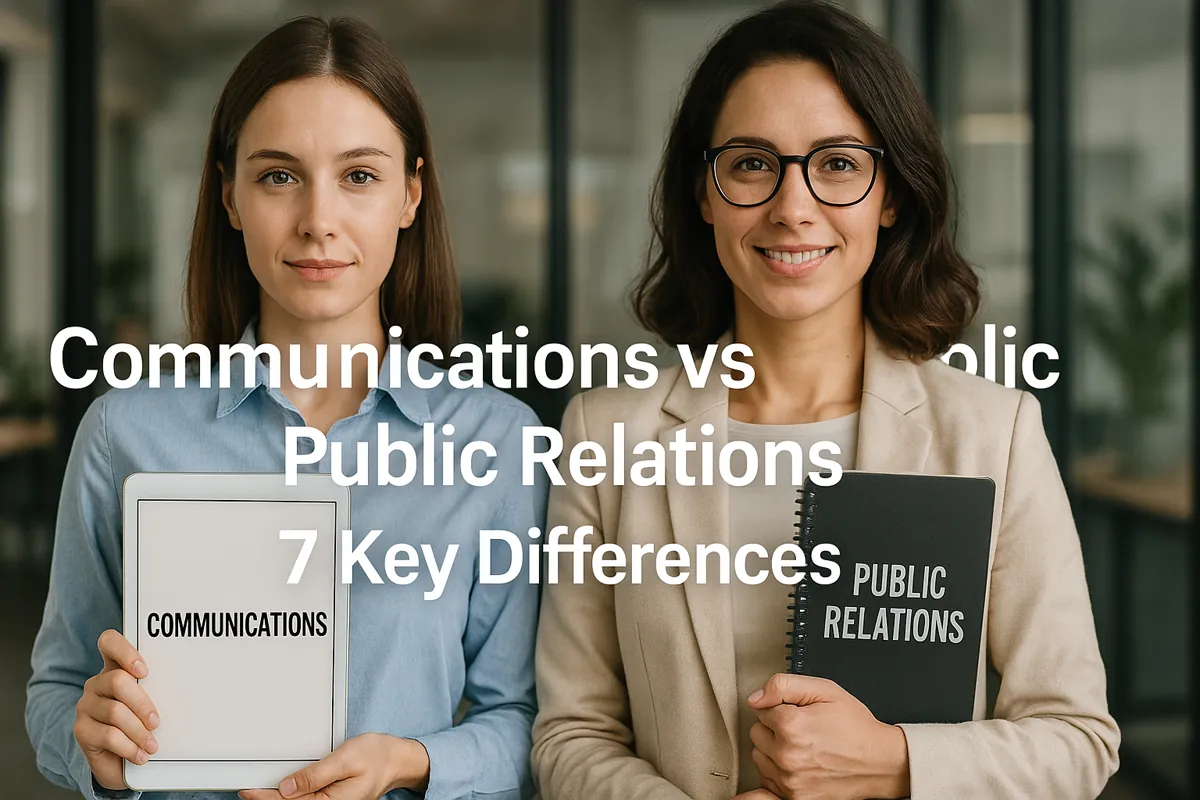
Amanda White
April 8, 2025
No Comments
Understanding the Core Purpose: What Sets Communications Apart from PR?
When discussing communications vs public relations, it’s easy to think they’re one and the same. After all, both deal with messaging, branding, and stakeholder engagement. But here’s the truth: while they do share some common ground, they’re not twins—they’re more like cousins with very different day jobs.
Corporate communications is the umbrella term that refers to how a company talks to all its audiences—internal and external. This includes employees, investors, customers, and even the general public. Think of it as the company’s voice. It involves crafting consistent messaging across different departments and ensuring alignment with the company’s mission and vision.
On the other hand, public relations (PR) is more focused. It’s the strategic effort to influence public perception and manage the organization’s reputation—usually through media, events, and crisis response. PR professionals are like storytellers and firefighters. They build relationships with journalists, respond to media inquiries, and help shape how the world sees the brand.
So, what’s the real communications and public relations difference?
Let’s break it down with a few key distinctions:
🌐 Scope of Work
Communications: Includes everything from writing internal newsletters to investor briefings.
Public Relations: Focuses more on external relations, such as press releases and public campaigns.
🧩 Goals
Communications: Improve understanding and engagement with all stakeholders.
PR: Build and protect the brand’s reputation in the public eye.
🛠️ Tools & Channels
Communications: Emails, intranets, corporate blogs, social media.
PR: Press releases, media interviews, crisis communication plans.
For example, a communications team might create a company-wide campaign on remote work policy, while the PR team manages media coverage about the company’s green initiatives.
If you’re still unsure about where these fields intersect and where they diverge, this detailed post—10 Ways Integrated Marketing Communications Boost Your Brand—offers excellent insights into how unified messaging plays a role in both.
Also, in today’s global business landscape, especially with remote work and cross-border teams, knowing the communications vs PR distinction can help leaders design better strategies. For instance, a company may use corporate communications to improve employee morale, while the PR team handles crisis messaging after a product recall.
So yes, the public relations vs communications debate isn’t just about job titles—it’s about the intent, audience, and tactics behind every message.
Understanding this difference matters more than ever, especially if you’re in a decision-making position at a global firm or managing international teams. Choosing the right talent or agency—whether for communications or PR—can directly impact your brand’s trust, cohesion, and long-term growth.
Table of Contents
Common Job Roles and Responsibilities in Corporate Settings
When comparing communications vs public relations, understanding the real day-to-day job roles can help you clearly see how these fields serve different (yet sometimes overlapping) purposes within a corporate environment.
Let’s start with corporate communications roles. These professionals are the backbone of a company’s internal and external communication. Their focus is on clarity, consistency, and alignment across all channels. Here are some common job titles:
🔹 Corporate Communications Manager
Oversees both internal and external messaging, making sure the brand voice is consistent across every touchpoint.
🔹 Internal Communications Specialist
Focuses on communicating with employees through newsletters, announcements, intranet posts, and all-hands meetings.
🔹 Investor Relations Officer
Prepares earnings reports, manages investor presentations, and acts as the liaison between a company and its shareholders.
Now let’s look at public relations roles, which are more externally focused:
🌟 PR Manager / Media Relations Specialist
Works closely with journalists, creates press releases, and organizes press conferences to gain positive media coverage.
🌟 Crisis Communications Lead
Steps in during brand crises to manage statements, media responses, and reputation recovery.
🌟 Public Affairs Officer
Deals with government relations and lobbying, especially in regulated industries like healthcare or energy.
While there’s overlap, the PR and communications comparison becomes clear when you consider the direction of communication. PR looks outward, trying to shape public opinion. Communications often looks inward—supporting company culture, leadership alignment, and employee engagement.
For example, during a company restructuring:
The internal communications team would explain the changes to staff, helping them understand what’s happening and why.
The PR team would manage media inquiries, ensuring the brand’s reputation stays intact.
Still curious how these roles create real business impact? This article, 5 Ways Internal Public Relations Can Improve Employee Engagement, dives deeper into how strategic internal messaging drives better performance.
And here’s a practical tip: If you’re building a team and wondering whether you need communications or public relations, think about your audience first. Do you need to inform and motivate employees? Or are you aiming to influence the press and public perception?
Also, whether your team is in New York, Berlin, or Seoul, tools like Learn English with online English teacher can ensure your communications and PR teams speak and write in polished, business-level English—no matter where they’re based.
So when weighing communications and public relations difference, think of it like this:
Communications helps the company speak clearly.
PR helps the company shine publicly.
How Each Field Supports Global Business Goals Differently
One of the most important questions when evaluating communications vs public relations is: How do these functions contribute to global business success?
For multinational companies, the answer can define your brand’s reputation, employee satisfaction, and customer loyalty. While both roles play strategic parts in building a company’s identity, they do so in very different ways.
Let’s begin with corporate communications. This function ensures that the entire organization speaks in one clear, consistent voice—whether you’re communicating internally across different time zones or sharing news across multiple languages. From onboarding emails to leadership updates, communications teams shape how employees understand the company’s vision.
💼 Examples of global business goals supported by communications:
Employee retention and engagement: Clear, motivating internal messages improve morale and reduce turnover.
Leadership alignment: CEO memos and internal videos can unify teams across continents.
Operational efficiency: Well-written manuals, policies, and project updates prevent confusion and delays.
Now let’s flip the coin to public relations. PR helps companies expand their reach, build trust with the public, and protect brand value—especially when operating in diverse markets.
🌍 How PR drives global success:
Market entry strategies: Launching in a new country? PR campaigns help introduce your brand with cultural sensitivity.
Media coverage: Effective PR builds media relationships that elevate your brand’s reputation abroad.
Crisis management: One bad review or misunderstanding can spread quickly. PR is your frontline defense.
A great example of PR impact? When a well-known beverage brand faced backlash over packaging waste, their PR team launched a global campaign about sustainability efforts. At the same time, their internal communications team sent employees updates to prepare them for questions. This kind of communications vs PR teamwork shows just how vital it is to have both functions in sync.
Want to see how this dynamic plays out in the remote work era? Check out 7 Remote Corporate Communications Jobs You Can Apply For Today to explore how companies are leveraging flexible communication roles worldwide.
In today’s hybrid, borderless work environment, the public relations vs communications distinction isn’t just theoretical—it shapes real outcomes. PR may secure a headline in Forbes, but communications ensures every employee, from São Paulo to Singapore, knows how that headline connects to their work.
And in terms of PR and communications comparison, both ultimately support brand equity, but through different audiences and tools. One talks to the world. The other talks to the team.

Essential Skills Needed for Communications vs Public Relations Careers
Whether you’re looking to hire, train, or become a top performer in either field, understanding the must-have skills is key. So what skills set professionals apart in communications vs public relations?
Here’s a breakdown—because while writing and strategy are critical in both, the focus and style of these roles call for different strengths.
📝 Top Skills for Corporate Communications Professionals:
Business Writing: Clear, concise internal memos, reports, and company-wide emails.
Change Management Communication: Guiding employees through reorganizations or policy updates.
Audience Analysis: Knowing how to tailor messages to executives, managers, or front-line workers.
Digital Tools: Mastery of intranet systems, Slack, internal newsletters, and survey platforms.
🗞️ Top Skills for PR Professionals:
Media Pitching: Crafting compelling stories and convincing journalists to cover them.
Crisis Communication: Staying calm under pressure and responding strategically to negative press.
Social Listening: Monitoring brand mentions and managing online sentiment.
Campaign Planning: Building multi-channel campaigns that resonate with a public audience.
Need help preparing for a job in these fields? Here’s a great guide: How to Get a Corporate Communications Internship in 5 Steps. Whether you’re fresh out of school or changing careers, it’s a practical place to start.
Also, professionals in both roles increasingly need excellent business language skills. A solid foundation in Business English is no longer optional—it’s a core requirement, especially for those working across international teams.
This brings us to the bigger question many ask: “Should I pursue communications or public relations?” If you enjoy structure, clarity, and internal culture building—communications might be for you. If you thrive in fast-paced environments and media-driven storytelling—PR may be a better match.
And when it comes to the communications and public relations difference, think of it as the difference between internal influence and external image-building. Both powerful. Both essential.
Real-World Examples: How Communications and PR Teams Operate Day-to-Day
Sometimes the best way to understand the communications vs public relations divide is to walk through a real day at the office. So let’s do just that—see how each team works in a typical week at a global company.
Corporate Communications Team
🕘 Monday Morning:
An internal memo goes out from the CEO announcing new sustainability goals. The communications team edits and formats it for clarity and tone, ensuring every employee understands the shift.
📢 Tuesday:
They prepare a slide deck for an internal town hall, translating complex data into visuals that speak to both engineers and sales reps.
🧑🏫 Wednesday:
The Learning & Development department needs help launching a new training program. The communications team creates promotional emails and FAQs for employees.
Public Relations Team
📰 Monday Afternoon:
A new product is launching. The PR team drafts a press release, schedules interviews with tech bloggers, and coordinates with influencers.
📱 Thursday:
There’s a trending social media conversation that could damage the brand’s image. The PR team crafts a quick response, while monitoring brand sentiment.
🎤 Friday:
A media training session is held for executives to prep them for a live interview on a business news channel.
In these examples, the public relations vs communications contrast becomes very visible. While the PR team is externally focused—telling the world the brand’s story—the communications team ensures the people inside the company are on the same page.
Want to explore more career examples? This post highlights some great roles: 10 Best Corporate Communication Jobs to Consider. Whether you’re new to the field or looking to specialize, it’s worth a read.
In summary, whether you’re considering communications or public relations, your typical day might look very different—but the goal remains the same: strong, strategic communication that builds trust and drives business forward.
Which Is More Flexible for Remote Teams and Phone-Based Communication Programs?
Now more than ever, companies are asking: what kind of communication system works best in a remote-first world?
If you’re weighing communications vs public relations, the remote adaptability of each function may surprise you.
📞 Corporate communications naturally thrives in remote environments. Whether you’re updating teams in Tokyo or Toronto, this function relies on tools like:
Zoom or Teams for leadership calls
Internal newsletters and emails
Company-wide platforms like Slack or Notion
At CorporateEnglish.biz, we see firsthand how corporate teams use our phone-based English program to improve internal messaging. Our native English teachers help employees practice real communication scenarios—whether they’re explaining a company change or discussing KPIs with overseas colleagues.
On the PR side, flexibility exists—but with caveats.
📰 Public relations often depends on live media interviews, in-person events, and real-time collaboration with multiple teams. These interactions can be adapted for remote work, but sometimes require more effort—especially in crisis response situations where timing and tone are everything.
That said, digital PR is evolving fast. Social media, influencer partnerships, and online pressrooms have made PR more adaptable than ever.
So how do you decide which path is best for your global or hybrid team?
🌟 Choose corporate communications if you need:
Ongoing employee engagement
Clear internal messaging across borders
Remote collaboration and training support
🔥 Choose PR if you need:
External campaigns for product launches
Media coverage in specific countries
Crisis response and online reputation management
In the ongoing communications vs PR debate, remote-readiness gives communications a slight edge—especially if your company has a decentralized or remote workforce.
Ultimately, understanding the communications and public relations difference helps leaders make better staffing, training, and messaging decisions across global offices.
How to Choose Between Communications or Public Relations for Your Company’s Growth
By now, you’ve explored the key differences, roles, and real-world examples that define communications vs public relations. But the final question is this: Which one does your company really need?
Let’s look at it strategically.
If your goal is to align global teams, improve internal understanding, and increase employee retention—then communications should be your priority. This team becomes the voice of your leadership and the glue that holds departments together.
But if your goal is to amplify your brand, reach new markets, and protect your public image—then PR is the way to go. A strong PR team helps you tell your story, respond to challenges, and stay top-of-mind with your audience.
In some cases, you’ll need both. That’s especially true for global companies balancing media exposure with internal cohesion. A recent example? A European tech company partnered with us at CorporateEnglish.biz to train both their PR and internal communications teams in English messaging. Why? Because whether you’re pitching to the press or writing a company-wide memo, clarity is everything.
Still deciding between PR and communications comparison strategies? Here’s a simple decision checklist:
✅ Are you struggling with employee engagement? → Focus on communications.
✅ Do you want to improve brand visibility in new markets? → Invest in PR.
✅ Is your company growing fast and needs clear messaging? → You probably need both.
Remember, choosing between communications or public relations isn’t a rivalry—it’s about finding the right balance. Many global firms blend the two functions to create one unified messaging department.
And if you’re ready to equip your team with the English skills to succeed in either path, check out our program or Contact Us | CorporateEnglish.biz for more information. We’re already helping European global corporations improve their communication game with our phone-based, native-speaker English lessons.
At the end of the day, the smartest companies know: great communication—inside and out—is what builds trust, loyalty, and long-term success.
Latest Blog







